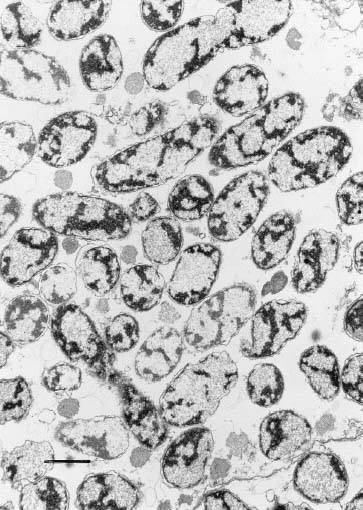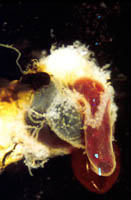Introduction
 | |
| http://microbewiki.kenyon.edu/images/f/fc/Wiggles3.gif |
Description of the Relationship
 |
| http://en.ird.fr/var/ird/storage/images/media/images/illustrations/photographies/glossina-fuscipes-gorgee-de-sang/37330-1-fre-FR/glossina-fuscipes-gorgee-de-sang1.jpg |
 |
| Mycetocyte in tsetse fly gut http://microbewiki.kenyon.edu/images/f/fe/Wiggles2.jpg |
Cost/Benefit Analysis
W. glossinidia offers Glossina spp. synthesized vitamins that Glossina is unable to acquire directly from its blood meals. This is why the absence of W. glossinidia is so detrimental to the tsetse fly, resulting in a severe decrease in life span and successful progeny. This benefit comes at the cost of increased susceptibility to trypanosome infection within Glossina.[3]
Glossina spp. offers W. glossinidia protection and a place to live at the cost of having its genome greatly reduced due to extended interaction and co-evolution. W. glossinidia possesses one of the smallest genomes of any living organism.[1]
References
- Dale, C., and S. C. Welburn. "The endosymbionts of tsetse flies: manipulating host-parasite interactions." International Journal of Parasitology 31. 5-6 (2001): 628-631. Web. 3 Apr. 2012. <http://www.sciencedirect.com/science/article/pii/S0020751901001515>.
- Aksoy, Serap, et. al. "Prospects for control of African trypanosomiasis by tsetse vector manipulation." Trends in Parasitology 17. 1 (2001): 29-35. Web. 3 Apr. 2012. <http://www.sciencedirect.com/science/article/pii/S147149220001850X>
- Pais, Roshan, et. al. "The Obligate Mutualist Wigglesworthia glossinidia Influences Reproduction, Digestion, and Immunity Processes of Its Host, the Tsetse Fly." Applied and Environmental Microbiology 74. 19 (2008): 5965-5974. Web. 3 Apr. 2012. <http://www.ncbi.nlm.nih.gov/pmc/articles/PMC2565960/?tool=pubmed>
LINK1
ReplyDeleteLINK2
LINK3
LINK4
LINK5